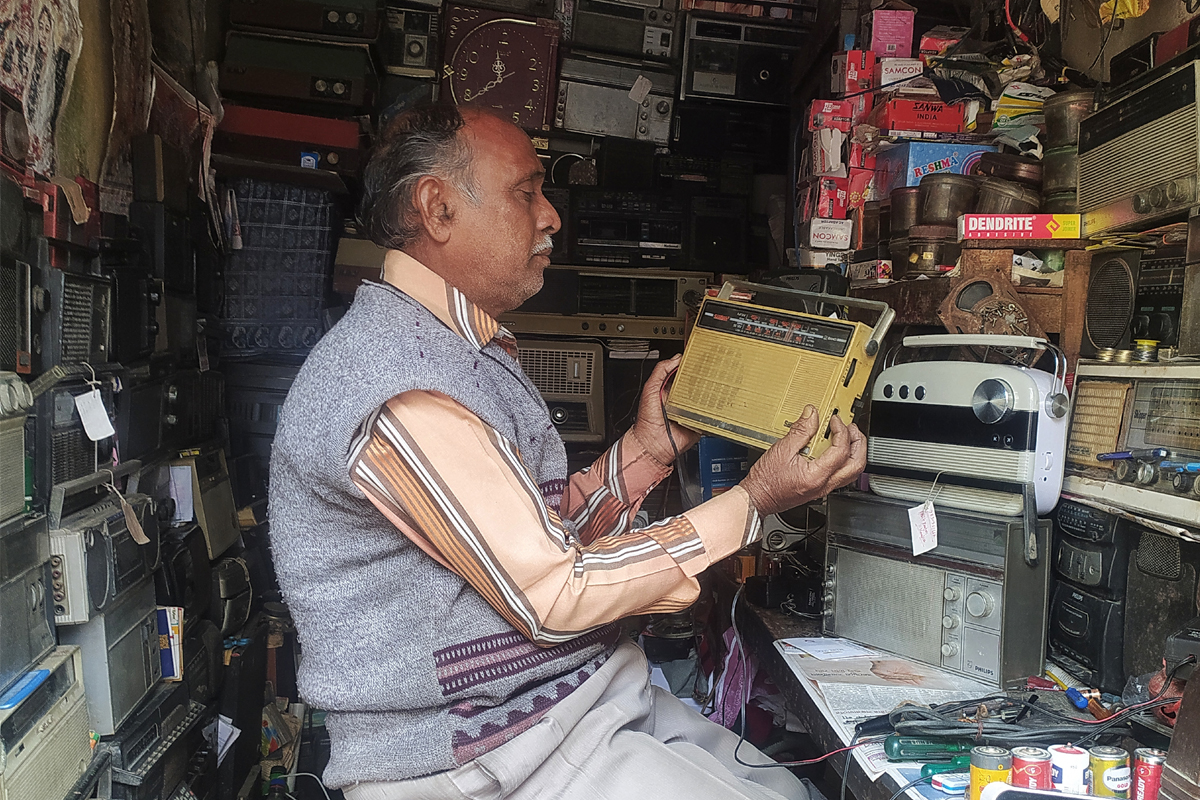Mahalaya: The unwanted debate surrounding a pious occasion
Mahalaya is the day that marks the beginning of Devi Paksha and Pitri Paksha or Pitru Paksha ends on the day
This shop was owned by his father, who later passed it down to him. Karmakar has been in business since the time when Siddhartha Sankar Ray was the chief minister of West Bengal.

Kumartuli in Kolkata needs no introduction. Here every angle has a frame, which is picture perfect as a backdrop to a setup where time has pressed its snooze button. Walking through the artistically inclined mazed lanes and bylanes of Kumartuli, gazing at the half-coloured idols and taking photographs along the way, The Statesman went on its mission to rediscover Kolkata’s last surviving radio repair shop.
Set against an unlikely background, Amit Ranjan Karmakar’s little radio shop on 40 Banamali Sarkar Street in the heart of Kumartuli, the potters’ colony, is easy to miss. This 66-year-old man flaunts his exquisite collection of almost 150 radio sets and has also been contentiously repairing old radio sets for decades. His passion for radio is infectious, yet still young.
This shop was owned by his father, who later passed it down to him. Karmakar has been in business since the time when Siddhartha Sankar Ray was the chief minister of West Bengal. Radio was the main source of entertainment for people back then. The auditory knickknack, because it lacked visuals, helped people frame their imagination. Karmakar recalls a time when customers would throng the shop, demanding their radios be fixed in time for cricket and football matches, news, several programmes, and mainly Mahishasurmardini, that have been broadcast every year since 1931 on All India Radio Kolkata. Also, entertainment shows programmed on channels like Vividh Bharati and Akashvani were the reasons that kept the folks of Bengal in demand for radios.
Advertisement
With the advent of television in the first half of the 21st century, there was a straight decline on the graph of demand for radios. Radio slipped into oblivion with this technological upgrade. A few shows, namely, Hawa Mahal, Man Chai Geet, Manoranjan, and Jay Mala, still air their shows on radios through FM channels, therefore holding up the legacy.
It was not until the advent of FM in the 90s that radio once again was in demand, though not as high as it was earlier before television. Karmakar says that artists like Rupankar Bhagchi, Nachiketa, Anjan Dutta, Suman Chattopadhay, and even bands like Chandrabindoo, LRB, Cactus once again flashed radio in front of people’s eyes.
Mahayala, every year, sets another dimension. Mahalaya becomes incomplete without this gadget as Bengalis wake up at the crack of dawn to listen to the sombre voice of the legendary Birendra Krishna Bhadra singing hymns of Mahayala on the radio, marking the beginning of Durga Puja, the annual grandest festival of Bengal. “I usually stay late in the shop and repair the sets till 1 am or 2 am, gulping up ghugni pauruti and cold tea just to keep myself full. Mahalaya has never disappointed me. It has always inundated me with work. Even those who have never listened to a radio before tune it on Mahalaya. Therefore, the sets, which are not in working condition, come to me,” says Karmakar.
According to him, 2020 was the year with the lowest amount of work since the pandemic had caused a sharp decline in festivities, yet he got to repair a few old sets. The pandemic was just another blip in the ever-turbulent market of supply and demand. But last year’s Durga Puja brought a new tide of revival. He repaired and delivered a total of 91 sets of these boxes in a single day. While revising about his previous year’s success, he got reminded of the day just before Mahalaya in the year 1981, when he delivered a total of 70 radio sets in that single day.
“After the emergence of digitalisation, I was rediscovered by the youngsters who came to Kumartuli to photograph the business of Kumartuli. These are the people who come to me with just one request! They say, Dadu, please make this work once again before Mahalaya. My grandfather had given this to my dad at his wedding. After the set is repaired, some of them call their grandfathers and listen to the functioning set over the phone. Some even pay me a hundred despite the actual amount (which is less than a hundred) out of sheer contentment,” he quips with a glint in his eyes. People also come from places like Agarpara, Kalyani, Sonarpur, Garia, and Mecheda to repair their vintage boxes.
Over the years, Karmakar’s shop has become a vehicle for emotions. This small shop with an impeccable vintage setup houses a magnificent collection, including Bush, Telefunken, Philips, and Murphy radios, making it a treasure trove for music lovers. He flaunts his nostalgic collections. Some of the radios were even used in film sets. One of those was displayed in the song Ami Cheye Cheye Dekhi Saradin in Uttam Kumar’s Deya Neya (1963). A Philips radio set was used in the song E Ki Holo, Kno Holo (1970) inside Tanuja’s house. Another set was used in the song, Jhar Uthechhe Baul Batas, from the 1995 film Shap Mochan.
Karmakar has been opening his shop at 7 a.m. sharp every day since 1976, and every Sunday he would put some of his rare sets along with his mementoes outside the shop for exhibition, therefore making it a mini-museum. Unfortunately, he is the last radioman in Kolkata who is working his fingers to the bone to persist in this age-old legacy, as he knows that radio will survive with him till his last breath, if not beyond him.
The writer is an intern at The Statesman
Advertisement